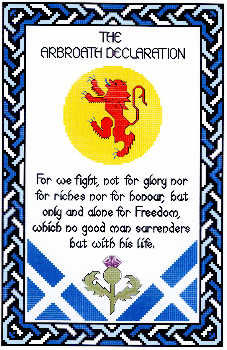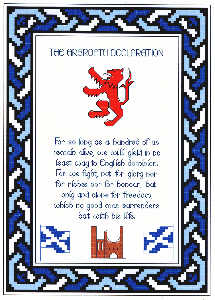 |
|
Arbroath Declaration (Aida)
Our
newest kit of the Declaration, pictured above, has been
designed to cater for all our customers who wanted a
Declaration kit specifically for Aida material. The
kit, which measures 8 x 12½ inches, comes with 14-count
Aida and and incorporates a 4-colour Celtic knotwork
border, a verse from the Declaration, a Lion Rampant,
Scottish flags and either a thistle as illustrated or
a picture of the ruined Arbroath Abbey - charts for
both are included.
|
| (To see detail from the Abbey version, click
here). |
| Price:
14.25 UK pounds
|

|
 |
| Arbroath Declaration (Evenweave) |
| Our
original kit of The Arbroath Declaration is on 27-count
white Linda evenweave and includes the most famous and
stirring phrase from the Declaration. Measuring
6 x 8¼ inches (150 x 210 mm), the kit includes a Celtic
knotwork border in four colours together with illustrations
of Arbroath Abbey, the Lion Rampant, and Scottish
Saltires. |
| Price:
12.00 UK pounds
|
 |
|
In
June 1314 King Robert the Bruce secured Scotland's independence
with his devastating defeat of Edward II's English army at the
Battle of Bannockburn. Nevertheless, Edward persisted in his claim
to sovereignty over Scotland and was supported in this by Pope
John XXII who, when writing to Bruce, addressed his letters to
"our beloved son Robert who says he is King of Scotland".
Bruce refused to recognise or respond to such letters and matters
came to a head when Bruce disregarded a summons to attend the
Pope at Avignon "under pain of excommunication".
An
impasse having been reached between King and Pope, the Scottish
nobles decided to intervene and the Declaration of Arbroath was
the result. Drafted in Latin by Bernard of Linton, Abbot of Arbroath
and Chancellor of Scotland, it was sealed at Arbroath Abbey in
April 1320 by eight earls and 31 barons and despatched to the
Pope. Signatories included Sir John Menteith, the man who
had betrayed William Wallace to the English but who later saw
the error of his ways. The document recorded that the Scots had
come originally from Scythia, settling in Scotland after a lengthy
sojourn in Spain, and pointed out that though often assailed by
the Norwegians, the Danes, and the English they had secured their
homeland over which had reigned an unbroken line of 113 kings.
Reminding the Pope of Scotland's connection with St Andrew, the
signatories went on to explain that they had been subjected to
untold miseries by Edward and, more particularly, his father Edward
I, but had been rescued from these by Robert Bruce who by due
consent and assent had been made their Prince and King. The most
famous passage from the Declaration reads: "For so long as
a hundred of us remain alive, we will yield in no least way to
English dominion. For we fight, not for glory nor for riches nor
for honour, but only and alone for Freedom, which no good man
surrenders but with his life".
The
Pope was to some extent swayed by the Declaration as, following
its receipt he wrote to Edward and some of his closest advisers,
recommending that they make an enduring peace with the Scots.
However, it was not until 1328 that
the Treaty of Edinburgh, concluded between Robert Bruce and Edward
III and sealed by the marriage of Robert's son David with Edward's
daughter Joanna, formally recognised Scotland's independence.
The
treaty only lasted four years; in 1332 it was breached by Edward
Balliol who invaded with an English army and had himself crowned
at Scone. His "kingship" lasted only months; defeated by Sir Archibald
Douglas at the Battle of Annan, Balliol fled across the border
to Carlisle "one leg booted and the other bare".
Even
today, the Declaration is of enormous constitutional importance
as it sets out the Scots relationship with their monarch. Scots
are not subjects; in Scotland, the monarch is merely "first
among equals", only ruling the people with their consent
and assent. Our present queen, therefore, is Queen of Scots, not
Queen of Scotland. This differs radically from the constitutional
position in England and Wales, where the people are subjects of
the monarch who rules them whether they like it or not.
As
Scots, we at Mearnscraft are very proud of the Declaration, an
historical affirmation of Freedom of which any nation should be
proud. We're particularly proud because Arbroath is in Angus,
our home county. We have therefore produced two kits relating
to the Declaration, one for Aida, one for evenweave. Both are
pictured on the left.
If
you like these kits, you'll almost certainly like our
Scotland Sampler
a
celebration in counted threadwork of the last thousand years of
Scottish history.
|
